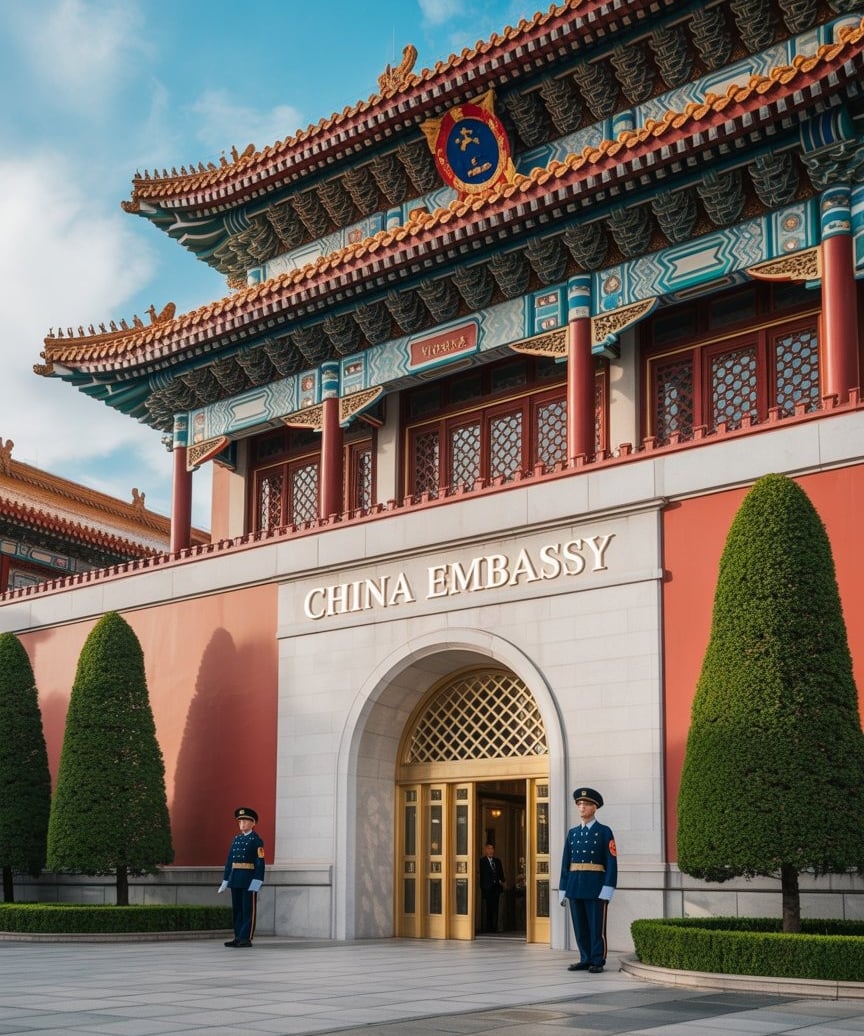Understanding China Embassy Attestation Process
Learn about the China embassy attestation process and its importance for international document verification. Discover how to ensure your documents are properly attested for use abroad.
11/17/20257 min read


Introduction to Attestation
Attestation is a formal procedure that validates the authenticity of documents, signifying their recognition and acceptance in international contexts. This crucial step involves certifying documents to ensure their legitimacy and to facilitate their use for various purposes beyond the original jurisdiction. Attestation becomes particularly important when individuals and businesses wish to present legal documents, such as educational certificates, commercial contracts, or personal identification papers, in foreign countries.
The process of attestation generally entails obtaining verification from designated authorities, which may include government institutions or embassies, ensuring that the document is genuine and properly executed. Different types of documents may require specific forms of attestation, depending on their nature and the country in which they are to be used. Commonly attested documents include birth certificates, marriage certificates, corporate documents, and diplomas, among others.
In this increasingly interconnected world, the role of document attestation cannot be overstated. It not only streamlines the process of international dealings but also reinforces the credibility of the documents presented. For anyone looking to engage in international affairs—be it for study, work, or business—understanding the nuances of attestation is fundamental, ensuring that their documents are in accordance with regulations and readily accepted abroad.
The Role of the Ministry of External Affairs (MEA)
The Ministry of External Affairs (MEA) plays a pivotal role in the attestation process, particularly for documents intended for international utilization. As an essential governmental body in India, the MEA is responsible for ensuring that Indian documents maintain their legitimacy when they are presented in foreign countries. This process is crucial, as it validates the authenticity of documents such as educational certificates, marriage certificates, and commercial documents, thereby facilitating their acceptance abroad.
The MEA attests a variety of documents, including but not limited to, educational qualifications, birth certificates, and legal documents. The attestation process begins with the submission of documents to the designated authorities. Typically, the process involves several steps, including obtaining verification from the respective state government departments or ministries. Once these preliminary verifications are completed, the documents can be submitted to the MEA for final attestation.
The procedure for submitting documents to the MEA follows a systematic approach. Applicants must ensure that their documents are duly authenticated by the relevant state authorities before presenting them to the MEA. After submission, the time frame for attestation can vary depending on the volume of requests and the complexity of the documents submitted. It is advisable for applicants to check the current processing times to manage their expectations appropriately.
The importance of the MEA's involvement in the attestation process cannot be overstated. By verifying and authenticating documents, the MEA provides a crucial service that not only facilitates international mobility but also enhances the credibility of Indian documentation on a global level. This function is essential for individuals and businesses alike, ensuring that their legal and personal documents will be accepted in foreign jurisdictions without complications.
China's Embassy Attestation Process
The attestation process for documents required by the Chinese Embassy for use in international settings is crucial for ensuring that documents meet the necessary legal standards. This process applies to various types of documents originating from India, including educational certificates, marriage licenses, and commercial documents. The attestation serves as a verification of authenticity, which is essential for legal validity in China.
To initiate the attestation process, one must gather the relevant documents and ensure they meet the submission criteria outlined by the Chinese Embassy. Typically, original documents along with photocopies are required. It is also important to have the necessary supporting documents, such as identification proof and previous attestations if applicable.
The specific requirements can vary depending on the type of document being submitted. For instance, educational documents often necessitate prior attestation from the Ministry of External Affairs (MEA) in India before being presented to the Chinese Embassy. The Ministry’s stamp adds an additional layer of verification, which is fundamental in the embassy’s assessment process.
Processing times for attestation can fluctuate based on the volume of applications at the embassy; generally, it can take anywhere from a few days to several weeks. Therefore, planning ahead is advisable, particularly when documents are needed for time-sensitive situations such as legal matters or business operations in China.
Fees for the attestation process vary, and it is essential to confirm the exact costs on the official embassy website or through authorized channels before submission. Navigating the complexities involved in this process may require assistance from professionals well-versed in international documentation and attestation. Thus, understanding each step and requirement is vital for a smooth experience when seeking attestation from the Chinese Embassy.
Comparison of MEA and Chinese Embassy Attestation Procedures
The attestation procedures for international documents can vary significantly between the Ministry of External Affairs (MEA) in India and the Chinese Embassy. Understanding these differences is essential for individuals seeking authentication of their documents for use in China.
The MEA attestation process begins with the verification of documents by issuing authorities, such as a notary or a designated agency. After the preliminary verification, the documents are submitted to the MEA, which checks their authenticity before providing its attestation. The timeline for the MEA attestation typically ranges from a few days to several weeks, depending on the complexity of the documents and the workload at the MEA’s offices.
On the other hand, the attestation process at the Chinese Embassy has its unique set of requirements. Initially, all documents must be notarized and, in some cases, approved by a local government authority before being submitted. The embassy then conducts its own verification and processing. This step usually takes between one to two weeks, though expedited services may be available at an additional cost.
Another significant difference lies in the requirements for intermediary agencies. For MEA attestation, applicants may sometimes need the assistance of an agency to manage the paperwork and processing. In the case of the Chinese Embassy, while it is possible to handle the application directly, many individuals opt for professional services to navigate the specific requirements effectively.
Both procedures ultimately aim to ensure that the documents presented are authentic and valid for international use. However, the varying requirements and timelines can lead to confusion for applicants. It is crucial for individuals seeking MEA and Chinese Embassy attestation to be well-informed about the specific steps involved in each process to avoid delays and ensure compliance with international standards.
Common Challenges in the Attestation Process
The attestation process, especially when dealing with the Ministry of External Affairs (MEA) and the Chinese Embassy, can present various challenges for individuals and businesses seeking to validate their documents for international use. One of the most prevalent issues encountered is document rejection. This may arise due to incomplete submissions, insufficiently authenticated documents, or failure to comply with specific regulations. Understanding the precise requirements for each document is crucial, as oversight can lead to significant delays in the overall process.
Another challenge is the lack of clarity regarding the attestation requirements. Individuals often find themselves confused by the differing procedures and necessary paperwork for the MEA and the Chinese Embassy. As regulations can vary greatly between these two entities, not knowing the exact steps involved can result in wasted time and resources. It is important to seek accurate information and, if possible, professional guidance to navigate these complexities effectively.
Delays are also a common concern during the attestation process. Due to high demand or bureaucratic inefficiencies, processing times may extend beyond what was initially anticipated. This can be particularly detrimental for businesses that require timely attestation for contracts or international partnerships. It is essential to consider potential delays when planning for international transactions to ensure compliance with deadlines.
Lastly, the necessity for additional documentation or verification can complicate matters further. There may be occasions when a document is initially accepted, only for further inquiries to arise later in the process that necessitate further proof or corroboration. To mitigate these challenges, maintaining meticulous records and proactively addressing any documentation requests will significantly enhance the efficiency of the attestation process.
Tips for Smooth Attestation
Navigating the attestation process for documents intended for use in China can be a challenging task, but with the right preparation and knowledge, individuals and businesses can simplify the procedure significantly. One of the foremost tips for ensuring a smooth attestation is thorough preparation of the documents. It is essential to gather all required papers, including birth and marriage certificates, educational diplomas, and any other relevant documents. If a document is not in the required language, it should be translated by a certified translator, as the Chinese embassy demands accurate translations to avoid complications.
Another critical aspect is ensuring compliance with the specific requirements of the embassy or consulate. Each embassy may have unique regulations and documentation formats. Therefore, it is advisable to check the official website or contact the embassy directly to obtain a list of requirements before initiating the process. This proactive step can prevent delays and help maintain a clear understanding of what is necessary for successful attestation.
Individuals should also be prepared for the possibility of unexpected issues arising during the attestation process. Having a contingency plan in place can alleviate stress. For instance, consider designating a point of contact or a trusted representative who can respond quickly if any unforeseen complications arise. Furthermore, tracking the progress of document submission can help identify potential bottlenecks. Utilizing a reliable courier service with tracking capabilities may enhance this aspect of the process.
Lastly, maintaining open communication with relevant authorities throughout the process is vital. This includes not only the embassy but also any local authorities involved in document notarization or verification. Clear and constructive communication will facilitate the overall attestation experience, paving the way for successful execution of the necessary formalities.
Conclusion and Next Steps
In conclusion, understanding the process of MEA and China Embassy attestation for international use is crucial for individuals and organizations seeking to validate their documents abroad. The Ministry of External Affairs (MEA) plays a significant role in attesting documents originating in India, ensuring their authenticity for international purposes. On the other hand, the China Embassy attestation further validates these documents specifically for use within China, ensuring compliance with local regulations.
Throughout the discussion, we have highlighted the importance of thorough preparation and awareness of the attestation process. Given that securing the necessary attestations can be time-consuming, it is advisable to plan ahead, allowing ample time for each step of the process. This includes gathering the required documents, submitting them for MEA attestation, and ultimately presenting them to the China Embassy for additional verification.
To help navigate this complex landscape, consulting with professionals specializing in attestation services is highly recommended. These experts possess in-depth knowledge of the MEA and embassy requirements, enabling them to guide individuals through the necessary steps efficiently. Furthermore, staying informed about any changes in the attestation process can prevent unexpected delays and complications, ensuring that all documentation is processed smoothly.
In light of this information, readers are encouraged to take proactive measures by reaching out to attestation service providers, establishing timelines for their documentation needs, and remaining vigilant about updates in the attestation protocols. Such steps will not only streamline the attestation process but will ultimately facilitate smoother international transactions and interactions.
